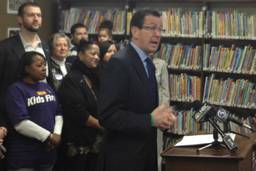
New Haven, Conn. – in early October, Lorenza Rodriguez Mendoza arrived in New Haven, Conn., to visit her daughter, whom she hadn’t seen in 10 years.
She and nine other women made the trip from Tlaxcala, Mexico, with a three-month travel visa to visit family members who had come to the United States to work.
The women’s journey began seven years ago, when they formed a community organization in Tlaxcala, the smallest state in Mexico. Many of New Haven’s Mexican immigrants come from this region.
Marco Castillo, an anthropologist from Tlaxcala, had passed through New Haven a couple of years earlier and met John Jairo Lugo, an organizer with Unidad Latina en Acci – n, a local grassroots group that supports undocumented immigrants.
Lugo has a biweekly radio show in Spanish called Barricada–or “Barricade” – on community station WPKN in Bridgeport, Conn., and he began devoting the last 15 minutes of each show to calls from Tlaxcaleños living in New Haven. Listeners in Tlaxcala would link to the program through the Internet, then broadcast it to Radio Universidad, where many community members could listen.
As the women in Tlaxcala heard their loved ones’ voices on the radio, they decided to visit them in the United States, through a celebration of their culture – their language, food and dance.
On Columbus Day weekend, they put together a dance performance that attracted about 150 people, Lugo reports. The celebration – called the First Festival for the Identity of the Americas – took place at a park in Fair Haven, a Mexican neighborhood of New Haven.
A dinner featuring food from Tlaxcala followed a week later at a local restaurant. Dozens of guests – both Mexican and Anglo – sampled traditional cooking.
“We don’t want to forget our roots,” says Manuela Cuapio, a social psychologist in Tlaxcala, who came to New Haven to visit her father. “We want the children who were born here to know their culture, too.”
Francisca Morales Rosete, who has six children in the United States, calls life in Tlaxcala isolated and lacking opportunity.
“We live in the country,” she says. “There are many poor people who don’t have the resources to send their kids to school. That’s why so many come to the U.S. There’s no work. Our kids walk around in huaraches [cheap Mexican sandals], not good shoes.”
Francisca says often families eat beans and corn tortillas three times a day.
Because of NAFTA, cheap tortillas made from U.S. corn have flooded Mexico. Tens of thousands of farmers, unable to compete with such low prices, have been forced off their land and into cities – or across the border – in search of jobs.
Nevertheless, as the U.S. economy has soured and many jobs have disappeared, the number of undocumented immigrants crossing the border has dropped.
An October 2008 report from the Pew Hispanic Center, using U.S. census data, noted that illegal immigration had declined to an estimated half a million annually since 2005, from an average annual rate of 800,000 from 2000 to 2004.
The children of these women have various jobs, from working in fast food restaurants to construction to domestic work. As the United States falls deeper into a recession, it’s likely that many immigrants will lose their jobs.
Lugo says that since the women arrived, the economic downturn has led to some job losses among their family members, but none of them have returned to Mexico. “What for?” he asks rhetorically. The workers say they have a better chance at a decent job in the United States than anywhere else.
Several other U.S. organizations working with immigrants in the country (including two on the Arizona border) say they have seen the occasional worker return to Mexico but no appreciable pattern of reverse migration.









